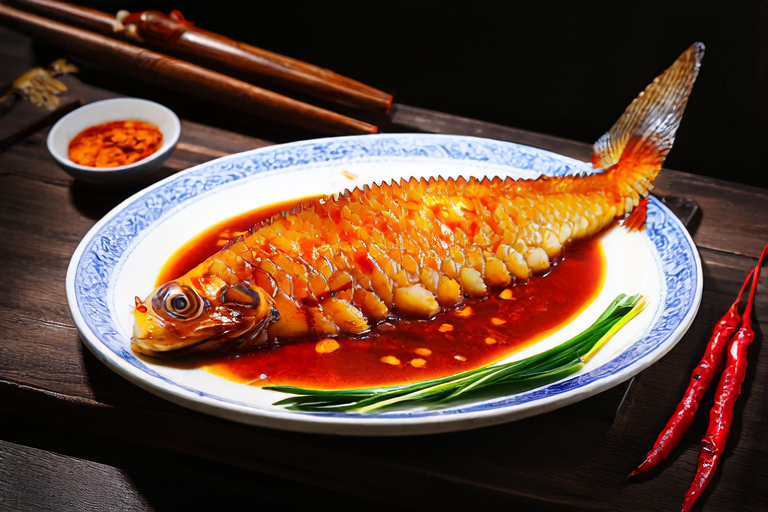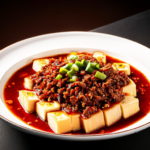Exploring the Flavors of Anhui: A Traditional Braised Mandarin Fish Delight
In the culinary world, few dishes can match the elegance and complexity of Anhui cuisine. Originating from the picturesque landscapes of Anhui Province in China, this regional cuisine is renowned for its rich flavors, meticulous preparation, and harmonious balance of tastes. Among the many exquisite dishes, one stands out as a true masterpiece: the traditional braised mandarin fish. This dish not only showcases the culinary prowess of Anhui but also embodies the essence of Chinese gastronomy.
The History and Significance of Braised Mandarin Fish
Braised mandarin fish, known as “Hongshu Yu” in Chinese, has a long history that dates back centuries. It is believed to have originated in the ancient capital of Huizhou, where it was served at banquets for emperors and nobles. The dish gained popularity during the Ming Dynasty (1368-1644) when it became a staple at imperial feasts. Over time, it evolved into a symbol of prosperity and good fortune, often featured on festive occasions such as weddings and New Year celebrations.
The significance of braised mandarin fish lies not only in its taste but also in its cultural symbolism. In Chinese culture, fish is associated with abundance and surplus due to the homophonic relationship between “fish” (鱼, yú) and “surplus” (余, yú). Thus, serving braised mandarin fish during important events is seen as a way to bring blessings and prosperity to the guests.
Ingredients and Preparation
To prepare this dish, you will need the following ingredients:
- 1 whole mandarin fish (approximately 1 kg)
- 2 tablespoons soy sauce
- 1 tablespoon rice wine
- 1 teaspoon sugar
- 2 cloves garlic, minced
- 1 tablespoon ginger, finely chopped
- 1 red chili, sliced
- 1 green chili, sliced
- 1 spring onion, chopped
- 1 tablespoon cornstarch
- 1 cup chicken broth or water
- Sesame oil (optional)
Step 1: Preparing the Fish
Begin by cleaning the mandarin fish thoroughly. Remove the scales, gills, and innards. Pat the fish dry with paper towels and score both sides of the fish lightly with a sharp knife. This will help the flavors penetrate deeper into the flesh during cooking.
Next, marinate the fish in a mixture of soy sauce, rice wine, and sugar for about 30 minutes. This step is crucial as it enhances the flavor profile of the fish and adds a subtle sweetness that complements the savory braising sauce.
Step 2: Preparing the Sauce
While the fish marinates, prepare the braising sauce. Heat a wok or large skillet over medium heat and add a small amount of oil. Sauté the minced garlic and chopped ginger until fragrant. Add the sliced red and green chilies and stir-fry for another minute.
Now, pour in the chicken broth or water and bring it to a simmer. Dissolve the cornstarch in a little cold water and slowly stir it into the sauce to thicken. Season with additional soy sauce if needed, ensuring the sauce is well-balanced in terms of saltiness and sweetness.
Step 3: Cooking the Fish
Once the sauce is ready, carefully place the marinated fish into the wok. Ensure the fish is fully submerged in the sauce. Cover the wok and let the fish cook gently over low heat for about 15-20 minutes. The cooking time may vary depending on the size of the fish, so keep an eye on it to avoid overcooking.
After the fish is cooked, transfer it to a serving plate and garnish with the chopped spring onions. Drizzle a bit of sesame oil over the top for added aroma and flavor.
Cooking Techniques and Tips
One of the key techniques in preparing braised mandarin fish is maintaining the right temperature throughout the cooking process. Using low heat ensures that the fish cooks evenly without becoming overly dry or falling apart. Additionally, the use of a lid helps retain moisture and allows the flavors to meld together perfectly.
Another important tip is to ensure the fish is properly cleaned and dried before marinating. Any excess water can affect the absorption of the marinade and may lead to uneven seasoning. Moreover, the scoring technique mentioned earlier plays a vital role in enhancing the texture and flavor of the fish.
Serving Suggestions
Braised mandarin fish is typically served whole on a platter, allowing diners to appreciate the presentation and enjoy the entire experience of eating a beautifully prepared dish. It pairs wonderfully with steamed rice or noodles, which help absorb the flavorful braising sauce.
For a complete meal, consider adding side dishes such as stir-fried vegetables or a simple salad. These complementary dishes provide a refreshing contrast to the richness of the fish and enhance the overall dining experience.
Nutritional Value and Health Benefits
Mandarin fish is highly nutritious, rich in protein, omega-3 fatty acids, and essential vitamins and minerals. These nutrients contribute to heart health, brain function, and overall well-being. Incorporating braised mandarin fish into your diet can be a delicious and healthy choice.
Moreover, the traditional method of braising the fish using soy sauce and other natural ingredients ensures that the dish is free from artificial additives and preservatives, making it a healthier option compared to many other processed foods.
Conclusion
Braised mandarin fish is more than just a dish; it is a testament to the rich culinary heritage of Anhui Province. Its intricate preparation, balanced flavors, and cultural significance make it a must-try for anyone interested in exploring the depths of Chinese cuisine. Whether enjoyed on a special occasion or as part of a regular meal, this dish promises an unforgettable culinary journey that will leave your palate satisfied and your senses delighted.


